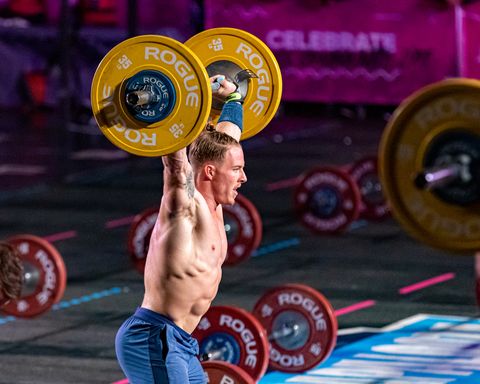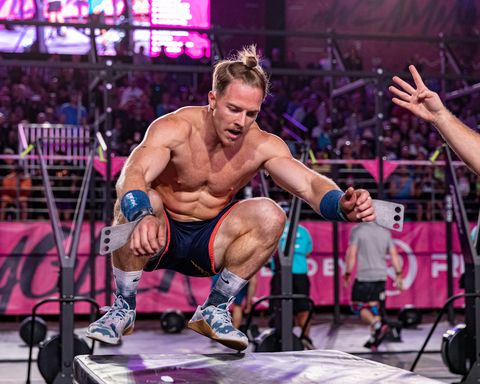Wodapalooza, the four-day Miami-based CrossFit Sanctional competition, doesn’t elect a king—you have to win the competition to get a crown, as Pat Vellner and Tia-Clair Toomey did at this years’ installment of the event—but if it did, Noah Ohlsen would be the clear favorite.
The hometown hero, who took second overall at the CrossFit Games last year, made his ninth Wodapalooza appearance in 2020, and fans flocked to give him fist bumps and get their hands on his “Happy but Hungry” merch. Ohlsen finished the competition in third place for Elite men and acknowledged the love from fans in an Instagram post.
Leading up to competition, Ohlsen did everything you’d expect to prep. He trained for hours a day, dialed in his nutrition plan, and then developed a game plan with his coach, Max El-Hag from Training Think Tank.
But there’s nothing like one CrossFit’s super challenging workouts to derail even the most talented athlete—so sticking to the training plan becomes even more important. Ohlen recommends the following five tips for anyone looking to improve their training or become a better competitor.
Noah Ohlsen’s 5 Training Tips

Eric Greenhalgh
Stick to Your Taper
Unlike the CrossFit Games, which springs events on participants immediately before the competition, Wodapalooza announced its first workout ahead of time: Luce, three rounds of a 1-kilometer run, 10 ring muscle-ups, and 100 air squats, all while wearing a 20-pound backpack. Ohlsen considers ring muscle-ups to be one of his strongest movements, but even after four practice sessions with the additional weight, he couldn’t get the technique down.
Even though the movement weren’t meant to be programmed in his training schedule, he decided to attempt them again two days before Wodapalooza—but under carefully managed circumstances.
“I found out that 10 reps was my max capacity,” he says. “I’m almost chicken-winging to get that tenth one, which isn’t smart to do so close to the competition. I also know that seven or eight reps is doable, but I wanted a session where I never got to that difficult point, where every rep felt good.”
Using those guidelines, Ohlsen chose to do three sets of five reps, exactly enough to adjust his timing while not burning himself out during his recovery period.
Know Your Benchmarks
When a workout starts, being able to pace yourself is crucial. That task is even easier to do on three common CrossFit apparatuses: the rower, the Assault bike, and the SkiErg, all of which tell you your strokes per minute, power output, and calories per hour. Though Ohlsen knows his speed may change based on the length of the workout and the movements before and afterward, he has three general guideposts to help him calibrate in the heat of the moment.
All Out: The maximum output he can generate for five to 10 seconds. On the SkiErg, it’s around 3,200 calories an hour.
Moderate: A pace that he can quickly hit and maintain before transitioning to another exercise—about 1,500 calories an hour.
Active Recovery: Smooth, easy, almost no effort—about 1,000 calories an hour.

Meg Ellery
Make Smart Adjustments in the Moment
On one of the “chipper” events (50 heavy wall-balls, 40 calories on the SkiErg, 30 dumbbell snatches, 20 box jump overs, and 15 bar muscle-ups), Ohlsen knew he’d have to hold an intense pace without redlining and imploding. Beforehand, he expected to ski around 1,500 calories per hour, but after he finished the heavy wall-balls and got pulling, he was only able to hit the high 1300s.
He wasn’t rattled. “Just because we said that’s what I should hit, I know it’s not going to be worth it cause that’s going to exhaust me,” he says. “And when I get to those dumbbell snatches, I’m going to have to break them up or work a whole lot harder.”
Ohlsen recalibrated based on how he was feeling, and he has the advantage of knowing his body exceptionally well. In fact, he’s discovered that his energy level isn’t necessarily correlated with how quickly his heart is beating. “My heart rate can be lower, but still, for whatever reason, the movements that I’m doing just fatigue me in a different way,” he says.
Prepare to Go Icy Cold
Wodapalooza 2020 had 5 team divisions, 34 individual divisions (17 for men and 17 for women), and multiple events running concurrently. In order to coordinate such a massive event, organizers had to ensure that the athletes were in place up to a half hour before their event started. That often meant that Ohlsen was stuck in less than comfortable conditions.
“We were just waiting on a concrete slab before one of the workouts, which had dumbbell bench press and thrusters, so to stay warm I did some push ups and air squats just to make sure I didn’t go out there completely cold.”
Ohlsen says that competitors can face similar waits at the Games as well. Other events like road races or triathlons have similar staging logistics, so if you’re looking to compete anywhere, know how to stay warm with just your body weight.

Nick Lents
Accept Your Choices, No Matter What
Even a day after Wodapalooza ended, Ohlsen wasn’t sure if his strategy on the rowing event paid off.
“I do feel like I probably could have given it a little finishing kick and sprinted at the last minute and done a little bit better. On the other side of things, if I had started off at a pace that didn’t make sense for me and just blasted it from the beginning, I could have exploded, and instead of taking 21st place, I take 40th place.”
Especially in CrossFit, creating the perfect strategy is an admirable goal to shoot for but likely impossible to achieve. Still, you can give yourself guidelines for how you work within your strategy as a way to control what little you can during those uncertainties. Keep these tips in mind, and with a lot of hard work, you could be rowing next to Noah Ohlsen at next year’s Wodapalooza. Miami’s hometown hero is almost sure to be there.

Source: Read Full Article
